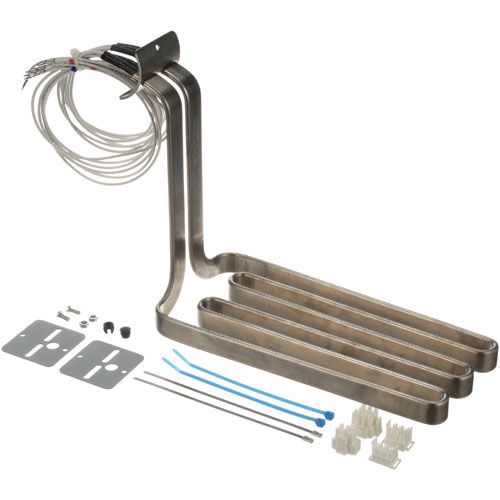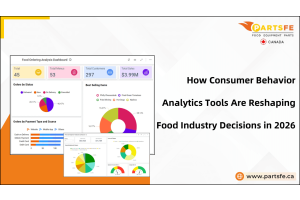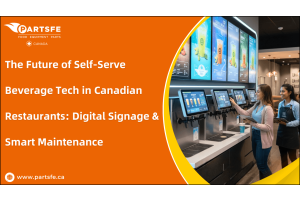The Digital Revolution: How Canada's Quick Service Restaurants Stay Competitive in a Tech-Driven World
Canada’s quick service restaurants (QSRs) are entering a new frontier where high-level digital intelligence, automation, and immersive technologies redefine competitiveness. Instead of relying on basic tools like kiosks, leading QSRs are exploring fully autonomous kitchens, AI taste-modelling systems that predict customer cravings, and ultra-personalized menu recommendations delivered through wearable devices. These innovations push the industry toward seamless, invisible technology that anticipates needs before customers express them.
To thrive in this rapidly evolving landscape, Canadian QSRs are adopting breakthroughs such as restaurant digital twins for operational simulations, computer-vision-driven quality control, drone and sidewalk-robot fulfillment networks, and mixed-reality customer engagement. By embracing these cutting-edge solutions, QSRs are transforming speed, accuracy, and personalization, setting new standards for the fast-food experience in a digitally intelligent world.
Why Digital Innovation Matters for Canada’s Quick Service Restaurants
Digital innovation is crucial for Canada’s quick service restaurants (QSRs) to stay competitive in a fast-paced, tech-driven market. Consumers increasingly demand speed, convenience, and personalized experiences, making technology a key differentiator. By adopting advanced digital solutions, QSRs can enhance operations, delight customers, and gain a competitive edge.
Key reasons why digital innovation matters for Canadian QSRs include:
-
Enhanced Customer Experience: AI-driven menu recommendations, app-based personalization, and loyalty programs boost satisfaction and repeat visits.
-
Operational Efficiency: Automation, predictive analytics, and smart inventory systems reduce waste, optimize staff allocation, and streamline workflows.
-
Faster Service Delivery: AI queue management, automated food prep, and digital order tracking improve speed and accuracy.
-
Data-Driven Decisions: Real-time analytics enable trend monitoring, demand forecasting, and agile business strategy.
-
Competitive Advantage: Early adoption of advanced digital tools attracts tech-savvy customers and strengthens brand positioning.
-
Sustainability Tracking: Digital systems help monitor energy use, reduce food waste, and support eco-friendly initiatives, appealing to conscious consumers.
-
Hyper-Personalization: Machine learning predicts individual taste preferences and tailors offers in real time, increasing engagement.
-
Crisis Resilience: Digital operations, contactless delivery, and cloud-based systems improve adaptability during disruptions like pandemics or supply-chain challenges.
By embracing these innovative solutions, Canadian QSRs can not only meet evolving consumer demands but also position themselves as leaders in a rapidly changing, technology-driven landscape.
Emerging Digital Technologies Transforming Canada’s Quick Service Restaurants
Canada’s quick service restaurants (QSRs) are adopting innovative digital strategies to stay competitive in a rapidly evolving, tech-driven market. These strategies focus on enhancing customer engagement, operational efficiency, and brand differentiation. Listed below are some of them:
Omni‑Channel Loyalty / Customer-Data Strategy:
QSRs utilize data-driven loyalty programs to reward customers across multiple channels, thereby boosting customer engagement.
Example: Subway Canada relaunched MVP Rewards, a tiered point-based system where users earn 10 points per $1 and get rewards via app, online, or in-store.
Proactive Order Preparation via Geofencing:
Digital tools notify staff when a customer approaches, enabling faster and more efficient service.
Example: McDonald’s Canada piloted “Ready on Arrival”: mobile orders trigger kitchen prep as the customer nears the restaurant.
Digital-First App Launch Strategy:
New app launches use promotions and digital campaigns to attract users.
Example: Pizza Hut Canada introduced a new mobile app offering a free large pizza on the first order and weekend discounts.
Digital Loyalty / Reward Challenges:
Gamified apps increase customer engagement and repeat visits.
Example: Burger King Canada’s Royal Perks app lets users earn “Crowns” per dollar spent and unlock rewards through challenges.
Digital Ordering Innovation / App Engagement:
Apps streamline ordering and create seamless digital experiences.
Example: Pizza Pizza’s app and website handle a significant portion of orders, including Apple Watch ordering.
Explore the future of dining: how digital menu boards are transforming restaurants and see how technology is reshaping customer experiences and boosting restaurant efficiency.
Measuring the Impact of Digital Transformation on Canadian QSRs
Canadian quick service restaurants (QSRs) are not just adopting digital tools, they are tracking measurable results to assess their effectiveness. Digital transformation impacts operations, customer engagement, and revenue in tangible ways.
Boosting Sales and Revenue: Digital channels now account for 11–25% of total sales, while average transaction size can increase by over 25% due to digital ordering and upselling.
Improving Order Accuracy and Speed: Digital tools help reduce order errors and streamline preparation, contributing to faster service and improved customer satisfaction.
Enhancing Customer Retention: Around 24% of Canadians use QSR apps or reward programs for deals, showing how digital loyalty systems drive repeat visits.
Optimizing Operational Efficiency: Restaurants using digital platforms have reported 23% growth in same-store sales, reflecting the efficiency gains from data-driven operations.
Refining Marketing Strategies: Digital coupons and promotions now reach 29% of consumers, increasing engagement and improving the effectiveness of marketing campaigns.
Advanced Predictive Insights: Real-time analytics help QSRs forecast demand, optimize inventory, and identify trending menu items.
Sustainability Tracking: Digital systems allow monitoring of energy use and food waste, helping restaurants reduce environmental impact and appeal to eco-conscious customers.
Cybersecurity and Data Privacy in Digital Canadian QSRs
As Canadian quick service restaurants (QSRs) increasingly rely on digital platforms for ordering, loyalty programs, and operations, cybersecurity and data privacy have become critical. Protecting customer information and business systems is essential to maintain trust, ensure regulatory compliance, and stay competitive.
-
AI-Powered Fraud Detection: Beyond traditional monitoring, AI can analyze transaction patterns in real time to flag unusual ordering or payment behaviors, reducing fraud.
-
Behavioral Biometric Security: Using typing patterns, touchscreen interactions, or app usage behaviors to authenticate users adds an extra layer of protection beyond passwords.
-
Data Minimization Practices: Storing only necessary customer data for limited periods reduces risk exposure if a breach occurs.
-
End-to-End Supply Chain Security: Securing not just the restaurant’s systems, but also cloud kitchens, delivery services, and third-party vendors, preventing weak links in the digital ecosystem.
-
Encrypted Customer Communications: Protecting messages, push notifications, and loyalty updates ensures sensitive promotional or personal data isn’t intercepted.
-
Privacy-First Personalization: Using anonymized or aggregated data for AI-driven recommendations, balancing hyper-personalization with privacy compliance.
-
Continuous Cyber Hygiene Training: Gamified or micro-learning modules for staff can reduce human error, the most common cause of breaches.
- Blockchain for Data Integrity: Emerging adoption of blockchain for loyalty points or transaction records ensures tamper-proof and auditable data.
Voice and Conversational AI in Ordering Systems
Beyond simple voice commands, Canadian quick service restaurants (QSRs) are exploring advanced conversational AI to deliver highly intuitive, efficient, and personalized ordering experiences.
Key areas include:
-
Emotion-Sensing AI: AI that detects tone, stress, or excitement in customer voices to adjust recommendations or prioritize service.
-
Cultural & Regional Dialect Adaptation: Tailoring voice recognition to understand regional Canadian accents, bilingual interactions (English/French), and Indigenous languages.
-
Proactive Voice Engagement: AI can initiate a conversation with loyal customers, reminding them of favorite meals or limited-time offers before they even ask.
-
Dynamic Menu Personalization: Based on time, location, and even weather, conversational AI adjusts recommendations (“It’s a chilly day, how about a hot soup combo?”).
-
Voice-Driven Contactless Payment: Customers confirm orders and pay entirely via voice, reducing touchpoints and enhancing hygiene.
-
Adaptive Learning from Group Orders: AI can handle multi-person orders efficiently, splitting bills or suggesting optimized combos.
-
Integration with Wearables & IoT Devices: Voice AI connected to smartwatches or car infotainment systems allows pre-ordering while commuting.
-
Predictive Wait-Time Announcements: AI informs customers of likely wait times before they commit to an order.
-
Voice Feedback Loop for Menu Innovation: Customers can leave real-time voice reviews, which AI transcribes and analyzes to influence menu updates.
These innovations turn conversational AI into an anticipatory, interactive, and operationally intelligent system, redefining how Canadian QSRs engage customers.
Read solo dining surge in Canada: a profitable opportunity for restaurants to understand how shifting guest habits are opening new revenue possibilities for operators.
The Future of Digital Innovation in Canadian Quick Service Restaurants
Canada’s quick service restaurants are redefining the dining experience by blending advanced AI, digital innovation, and operational intelligence. Success will come from hyper-personalized customer engagement, seamless technology integration, and robust cybersecurity. Those who balance innovation with trust and sustainability will lead the next era of fast, intelligent, and responsible QSRs.
Key Takeaways:
-
Neural Feedback Integration for Menu Design: Using non-invasive neural sensors (like EEG headsets in pilot programs) to test real-time emotional responses to new menu items, optimizing for subconscious customer appeal.
-
Predictive Environmental Impact Analytics: AI models that forecast the environmental footprint of menu items before production, helping QSRs tweak operations for sustainability and regulatory compliance.
-
Quantum-Optimized Delivery Routing: Experimental use of quantum-inspired algorithms for hyper-efficient drone and robot delivery paths in congested urban areas.
-
Digital Twin Gastronomy Testing: Creating virtual replicas of kitchens and menus to simulate customer taste satisfaction before launching new items, reducing trial-and-error in physical locations.
-
Hyper-Localized Menu Variants: Leveraging geospatial and demographic microdata to create location-specific menu adjustments down to neighborhood-level taste profiles.
-
IoT-Powered Waste-to-Reward Programs: Sensors track food waste in real time and automatically translate reductions into loyalty points for eco-conscious consumers.
-
Cognitive Load Reduction Interfaces: Designing apps and kiosks that adapt interface complexity based on customer familiarity, reducing decision fatigue and speeding up ordering.
-
Autonomous Culinary Experimentation: AI-guided kitchen robots can test micro-variations of recipes overnight, feeding live customer feedback data to refine menu innovation continuously.
Canadian QSRs are transforming through next-gen digital tools, intelligent automation, and secure, customer-focused solutions. By integrating technology thoughtfully, restaurants can deliver speed, personalization, and sustainability while maintaining trust. The future belongs to those who innovate boldly yet responsibly.
Looking to future-proof your quick service restaurant with the right equipment replacement parts? PartsFe CA offers high-quality components for essential kitchen equipment like ovens, fryers, grills, and refrigeration units, backed by trusted brands such as Pitco, Hobart, and True. Upgrade your equipment with PartsFe CA and keep your operation running smoothly.
References:
https://pmc.ncbi.nlm.nih.gov/articles/PMC10742996/
https://www.cnbc.com/2023/06/17/restaurant-ai-streamline-food-prep-ordering.html
https://www.restaurantscanada.org/canadas-2025-dining-trends-are-out-coupons-digital-first-and-the-hot-sandwich-climbing-the-most-popular-menu-items-chart/
https://digitalmainstreet.ca/event/how-restaurants-in-canada-use-tech-to-compete-in-2025-and-beyond/
FAQs
How much does it cost for a QSR to adopt digital transformation technologies like voice AI or automation?
Costs vary based on scale and complexity, ranging from a few thousand to tens of thousands of dollars for AI or automation systems. Subscription-based platforms can start at $50–$500/month, depending on usage and integration needs.
Why is investing in digital transformation worthwhile for QSRs?
Digital transformation improves efficiency, reduces waste, and enhances customer satisfaction through personalization and faster service. It also drives higher loyalty and increases average order value.
How do QSRs measure the ROI of digital transformation initiatives like AI ordering or automation?
ROI is tracked through increased sales, faster service times, reduced errors, and higher customer retention. Analytics platforms provide real-time insights to quantify operational improvements.











